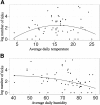Ixodes ricinus abundance and its infection with the tick-borne pathogens in urban and suburban areas of Eastern Slovakia
- PMID: 23952975
- PMCID: PMC3751762
- DOI: 10.1186/1756-3305-6-238
Ixodes ricinus abundance and its infection with the tick-borne pathogens in urban and suburban areas of Eastern Slovakia
Abstract
Background: Raising abundance of ticks and tick-borne diseases in Europe is the result of multiple factors including climate changes and human activities. Herein, we investigated the presence and seasonal activity of Ixodes ricinus ticks from 10 urban and suburban sites in two different geographical areas of southeastern and northeastern Slovakia during 2008-2010. Our aim was to study the abundance of ticks in correlation with the environmental factors and their infection with Borrelia burgdorferi sensu lato, Anaplasma phagocytophilum and Neoehrlichia mikurensis.
Methods: Questing I. ricinus ticks were collected from ten urban and suburban sites in Eastern Slovakia. A total of 670 ticks were further analysed for the presence of B. burgdorferi s.l., A. phagocytophilum and N. mikurensis by molecular methods. Tick site and environmental relations were analysed using General Linear Models (LM). The differences between the number of Lyme borreliosis cases between the Košice and Bardejov regions during a ten-year period were tested by Wilcoxon matched pairs test.
Results: In total, 2921 (1913 nymphs, 1008 adults) I. ricinus ticks were collected from 10 study sites during the main questing season. Tick activity and relative abundance differed between locations and months. Temperature and humidity were the main factors affecting the tick abundance and questing activity. Out of 670 examined ticks, 10.15% were infected with spirochetes from B. burgdorferi s.l. complex (represented by B. afzelii, B. garinii, B.valaisiana and B. burgdorferi s.s.), 2.69% with the A. phagocytophilum and 2.39% with N. mikurensis. The number of Lyme borreliosis cases per 100,000 inhabitants in the Bardejov region was significantly higher than in the Košice region.
Conclusions: Our data indicate that the risk of infection with tick-borne pathogens in Eastern Slovakia is common since 15.2% of ticks were infected at least with one of the tested microorganisms. Even though the abundance of ticks was affected by the microclimatic conditions and the prevalence of pathogens differed between the habitats, the infection risk for humans is also affected by human activities leading to an increased contact with infected ticks.
Figures





References
-
- Materna J, Daniel M, Danielová V. Altitudinal distribution limit of the tick Ixodes ricinus shifted considerably towards higher altitudes in central Europe: results of three years monitoring in the Krkonose Mts. (Czech Republic) Cent Eur J Public Health. 2005;13:24–28. - PubMed
-
- Medlock JM, Hansford KM, Bormane A, Derdakova M, Estrada-Peña A, George JC, Golovljova I, Jaenson TG, Jensen JK, Jensen PM, Kazimirova M, Oteo JA, Papa A, Pfister K, Plantard O, Randolph SE, Rizzoli A, Santos-Silva MM, Sprong H, Vial L, Hendrickx G, Zeller H, Van Bortel W. Driving forces for changes in geographical distribution of Ixodes ricinus ticks in Europe. Parasit Vectors. 2013;6:1–11. doi: 10.1186/1756-3305-6-1. - DOI - PMC - PubMed
Publication types
MeSH terms
LinkOut - more resources
Full Text Sources
Other Literature Sources
Medical
Molecular Biology Databases

